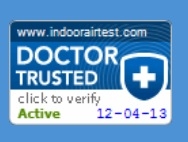News
Mycotoxins a Toxic Health Hazard
Mold toxins, e.g. Trichothecens Mycotoxins, in buildings damaged by moisture are considerably more prevalent than was previously thought, according to new international research.
Washington DC -- Mycotoxins are chemical substance produced by the fungal metabolic process. As a matter of fact, these compounds are the secondary metabolites of fungal metabolism. Due to the absence of common molecular feature, the chemical category of these compounds is still not very certain. Commonly, the fungi producing such chemicals are categories as toxigenic fungi. Mycotoxin plays a pivotal role in regulating competition with other microorganism besides helping the parasitic fungi in invading the host tissues. These compounds may also effects human health adversely. The kind and amount of mycotoxin produced by a fungus depend on the fungal strain, the substrate it is metabolizing, and possibly the presence and absence of other organisms.
It is recognized today by a large body of medical literature and extensive clinical experience indicating that high exposures to indoor airborne mold can lead to disease in otherwise healthy individuals. Mold toxins, e.g. Trichothecens Mycotoxins, in buildings damaged by moisture are considerably more prevalent than was previously thought, according to new international research. Erica Bloom from the Division of Medical Microbiology at Lund University in Sweden has contributed to research in this field by analyzing dust and materials samples from buildings damaged by mold. Virtually all of the samples contained toxins from mold.
In several cases, trichothecene mycotoxicosis was caused by a single ingestion of bread containing toxic flour or rice. In experimental animals, trichothecenes are 40 times more toxic when inhaled than when given orally. Trichothecenes were found in air samples collected during the drying and milling process on farms, in the ventilation systems of private houses and office buildings, and on the walls of houses with high humidity. In addition, there have been some reports showing trichothecene involvement in the development of "sick building syndrome". The symptoms of airborne toxicosis apparently disappeared when the buildings and ventilation systems were thoroughly cleaned.
“Previously it was claimed that the occurrence of mold does not necessarily mean that there are toxins present. But they are! On the contrary, we can assume that wherever there is visible mould, there are also mold toxins,” says Erica Bloom.
And toxins produced by mold are more potent than was previously thought. It has now been shown, for instance, that mold toxins (mycotoxins) not only directly kill cells but can also affect immune cells in a way that increases the risk of allergies. Even incredibly tiny amounts of these toxins can do this, as little as a few picograms (a picogram is one millionth of a millionth of a gram).
New research also shows that mold releases extremely small particles that remain suspended in the air, and can get into our lungs much more easily than the spores that have previously been focused on. This can increase exposure to mould and mycotoxins hundreds of times over compared with previous calculations. And mycotoxins have further been shown in laboratory studies to have a synergistic effect: the effect of two toxins is not merely 1 + 1 but much greater.
In the aftermath of storms, hurricanes, tornadoes, general moisture intrusion world renowned microbiologist Dr. Rajiv Sahay, Director of Environmental Diagnostics Laboratory (EDLab), a division of Pure Air Control Services reminds residents to be wary of what floodwaters leave behind—mold, bacteria in the form of e coli (sewage backup) and potential tricothecene mycotoxins (toxic mold) growing on walls, behind walls, in the ceilings, under the carpets, or in their ductwork.. Also, Dr Sahay warns of what unqualified disaster restoration firms leave behind…trouble.
Common manifestations of trichothecene toxicity are depression of immune responses and nausea, sometimes vomiting. The first recognized trichothecene mycotoxicosis was alimentary toxic aleukia in the USSR in 1932; the mortality rate was 60%.
Detection and Estimation:
Detection and estimation of mycotoxin are not an essay task because of its variable nature. Toxin production may also be influenced by several environmental conditions such as medium, temperature and competition with other microbes. This task is more complicated due to nonuniform distribution, uncertainties in sampling and analysis of mycotoxin. Some time even one fungi are capable of producing more than one type of mycotoxin including many that remain uncharacterized.
A number of techniques can detect and estimate mycotoxin. Some of the prominent techniques include thin layer chromatography (TLC), high performance liquid chromatography (HPCL) and gas chromatography-mass spectrometer (GC-MS), Immunosorbent assay (ELISA), capillary electrophoresis (CE) etc. However, analytical techniques for mycotoxin analysis are improving day by day. Specially, due to growing concern of indoor air quality and building related problems. It is necessary to find a technique that can provide rapid, reliable and authentic information about the quality and quantity of the mycotoxin.
The Environmental Diagnostics Laboratory at Pure Air Control Services provides an ELISA based technique (Limit of Detection is 0.14 parts per billion) for the rapid screening of trichothecene mycotoxin. Environmental samples such as dry wall, carpet, office supplies, air filter, dust and other like wise sample obtained from various test sites like schools, homes, hospitals, work places and other indoor environmental site are acceptable for trichothecene mycotoxin evaluation. Provide a chain of custody (COC) when submitting samples to the lab. Also the portion of same sample can be use for testing mold/fungi by performing addition tests.
A do-it-yourself (DIY) screen test called Mycotox Screen Check (TMC) tests kits are available at Building Health Check, LLC www.INDORAIRTEST.com, Grainger, Hunter fans and other fine retailers or call 1-800-422-7873 ext 403. Should you need a COC form email request to: iaq@pureaircontrols.com or ask the customer rep when you call the 800 # (USA Only) or outside the US 1-727-572-4550.
For a more extensive, comprehensive analysis of your home or building you can contact the Building Scientists at 1-800-422-7873 ext 802.
About Pure Air Control Services:
Alan Wozniak founded Pure Air Control Services, Inc. in 1984 as a small mechanical contracting firm. Today, the firm sets the industry standard for indoor environmental quality diagnosis and remediation.
Pure Air Control Services is a national provider of the following IAQ services: Building Sciences Evaluation; Building Health Check (USP 797 monitoring compliance); Environmental Diagnostics Laboratory (EDLab) an AIHA accredited micro laboratory (USP 797 Lab analysis); DIY IAQ Green Check test kits, Environmental Project Management; HVAC System Cleaning and Mold Remediation Services among other indoor environmental services.
The company’s expanding valued client roster includes the General Services Administration (GSA); Federal Aviation Administration (FAA), Allstate Insurance; Carrier Air Conditioning; Naval Air Warfare Center, Orlando; and Naval Air Station - King's Bay, Georgia, and many other Fortune 500 companies, school boards, and city, state, and county governments, making Pure Air Control Services the reliable industry leader in IAQ.
For more information on Pure Air Control Services, Inc. please contact Alan Wozniak at (800) 422-7873 x 804, or visit www.pureaircontrols.com.

More News

IAQ Test Kits (DIY), PURE-Steam Coil Cleaning and PURE-Decon Room Treatment Showcased at the Annual FRACCA Conference
This annual event provides an opportunity for licensed contractors throughout the State of Florida to obtain all 14 state-required hours of continuing education over the course of the two-day event.
Released On: 3/8/2014
Views: 4359

Free Legionella Webinar: Detection & Identification Workshop
Although this type of bacteria was around before1976, more illness from Legionnaires' disease is being detected now. Due to consumer awareness, added research and technological advances in healthcare Legionnaires disease identification is becomi ...
Released On: 3/4/2014
Views: 4214

Why Some High-Performance Buildings Are Failing?
Performance of a building depends on its structured integrity, preventive maintenance, as well as periodical monitoring of the environmental conditions essential for its functionality.
Released On: 2/19/2014
Views: 4245

Legionnaire’s – What You Should Know About The Potential Deadly Bacteria
According to Building Operating Management magazine, expert Victor Yu, MD, Professor of Medicine, University of Pittsburgh; Chief, Infectious Disease Section, VA Medical Center, Pittsburgh, PA, disclosed that “Up to 70% of all buildings greater t ...
Released On: 2/18/2014
Views: 3805

Managing of Indoor Environments: Problems and Solutions - IEQ WEBINAR
Released On: 1/22/2014
Views: 3702

Save Energy and Improve Indoor Air Quality (IAQ) with PURE-Steam Deep Coil Cleaning
High efficiency coils are extremely susceptible to blockage from dust accumulation because once lodged deeply within the fins bacteria and mold may initiate growth, which not only compounds the blockage problems but also gives rise to excessive o ...
Released On: 1/8/2014
Views: 6478

January is National Radon Action Month
Exposure to radon is the second leading cause of lung cancer after smoking. Radon is an odorless, tasteless and invisible gas produced by the decay of naturally occurring uranium in soil and water.
Released On: 1/8/2014
Views: 4137

Why indoor air quality is important to all of us?
World Health Organization (WHO Guidelines for Indoor Air Quality, 2009) concluded that the most important effect is increased prevalence of respiratory symptoms, allergies and asthma, as well as perturbation of the immunological systems
Released On: 12/31/2013
Views: 4193

Pure Air Control Services Launches New Interactive Website
The website is a true indoor environmental resource for the private and public sector including consumers, educational facilities e.g. schools, universities, along with city, county state and federal governments, healthcare and the public sector.
Released On: 12/20/2013
Views: 3191

Pure Air Control Services Awarded Certification from Doctor Trusted
“We are very proud to have been given the opportunity to display that we are a Doctor Trusted recipient. We will continue as always to help provide our customers with a great products and services,” stated Dr. Rajiv Sahay, environmental analytica ...
Released On: 12/11/2013
Views: 4138

IndoorAirTest.com Receives Seal of Approval by Doctor Trusted
IndoorAirtest.com is very proud to have a Doctor Trusted seal of approval displayed on our website, giving our customers more confidence when shopping with us.
Released On: 12/4/2013
Views: 4563

PURE-Decon/Sanosil, Reduces Sick Days Caused by Infection
Released On: 10/2/2013
Views: 3490

Controlling Asthma & Allergy Triggers Through Source Identification
The assessment of allergens in a house dust sample is an essential step for allergen-avoidance and provides information essential for allergen-reducing measures, in addition to managing the indoor environment from a health and hygiene point of view
Released On: 9/18/2013
Views: 5583

Hospitals Get a “Clean Bill of Health” with Innovative IAQ/Energy Solutions
Healthcare-associated infections (HAIs) are infections that patients acquire during the course of receiving healthcare treatment for other conditions.
Released On: 7/31/2013
Views: 4611

How Safe is Formaldehyde in our Buildings and Homes?
Released On: 7/17/2013
Views: 4883

Commercial Energy Solutions Seminar July 26, 2013
Released On: 7/11/2013
Views: 4939

Health Risks Associated With Indoor Microbes
Some common and frequently reported microbes of the indoor environment include, but are not limited to, viruses, bacteria, mycoplasma, mold (fungi), yeast, protozoa, etc.
Released On: 6/26/2013
Views: 6093

Aspergillosis: A Cause for Indoor Concerns?
In indoor environments, this fungus can be transported from outside or may propagate on building materials such as cellulose rich sheet rocks, etc. and can generally be isolated from floors, carpets, mattress dust, Heating Ventilation Air Conditi ...
Released On: 6/19/2013
Views: 10793

Map
Pure Air Control, Services, Inc.
Get DirectionsPure Air Control, Services, Inc.
-
4911 Creekside Drive
Clearwater, Florida 33760
United States - 1 (800) 422-7873


